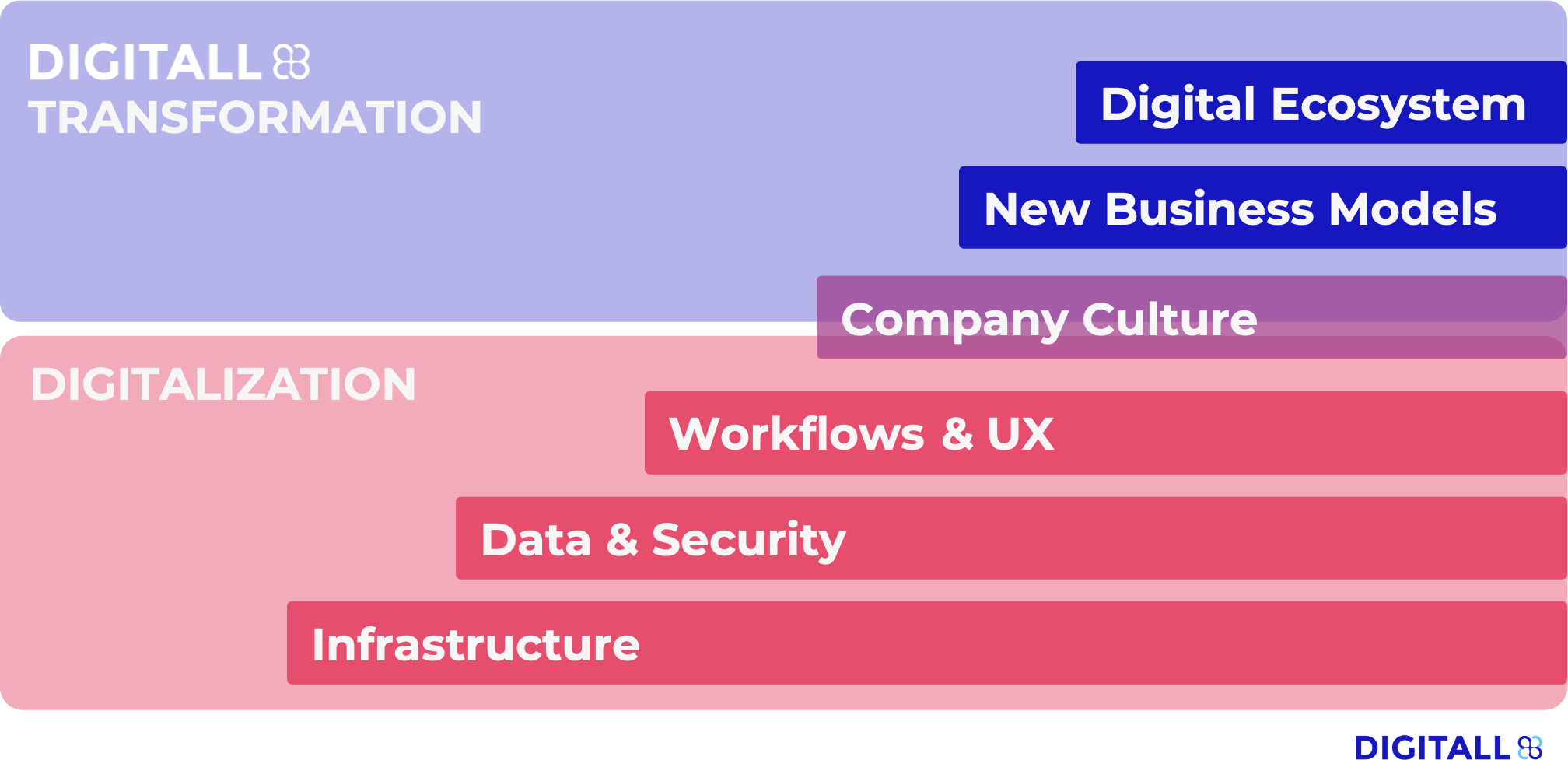2 min read
Why Customer Experience Is Becoming the Ultimate Competitive Edge
Products can be replaced, prices can be compared, but experiences last. In the chapter “Customer...

4 min read
The digital transformation can be a huge opportunity for businesses once they go beyond the need to digitize for its own sake.
Tl;dr: The DIGITALL pyramid of needs prioritizes a business' digitalization strategy based on its direct needs (infrastructure, process optimization & data security) to reach the point where it is ready to truly transform through its culture and create new business models.
Content:
1. The pyramid of (digital) needs
2. Your culture shapes your future
Why does a business want to digitize? For many, it's to safe resources by optimizing processes. Others need to offer digital channels for their stakeholders to keep their business afloat. Often, the plan to transform the business comes from a direct need. During the pandemic, for example, businesses with stationary shops had to pivot towards digital channels. Employees suddenly needed to work remotely which put a lot of company's under pressure to digitize previously analog communication processses. And the loss of many supply chains put an urgent need on transparency of production- and delivery models, especially with third parties involved.
But what happens when you've started your digitalization projects and met the most urgent requirements? What if you secured your data according to national and international regulations, when you automated processes to safe resources, when you managed to digitize both your customer channels as well as your internal work and communication channels?
It won't be the end of your digital transformation, that's for sure.
Maybe you have heard of the Maslow pyramid of needs. Developed by the American psychologist Abraham Maslow, it simplifies how certain needs are more urgent than others and how an urgent need usually needs to be met first before another need can be tended to.
Now, the pyramid is not without its flaws, obviously, but it's a helpful start to visualize that to reach the top tier of the pyramid you need to meet your basic (and most pressing) needs first.
So, how about a pyramid or rather order of needs for the digitalization of businesses?

You'll notice that the pyramid has two different sections: Digitalization and Digital Transformation. One could assume that both these words are synonymous but according to Paul Leinwand and Mahadeva Matt Mani*, digitalization is about "enabling business as usual and 'staying in the game', whereas digital transformation is "about building real, long-term competitive advantage to succeed."
Basically, digitalization makes sure that your business can stay afloat, work its basic needs and keep up with demands just so.
Find out how pharma company Engelhard managed to replace their old CRM, prepare their data for successful migration, and connect its other systems to digitize their business further.
However, digital transformation actually uses digitalization to not just keep your business afloat but make something more, new and exciting out of it. However, I am convinced that this only works if the basic needs of a business are met when it comes to digitalization. And it's one of the main reasons why so many businesses struggle with their transformation strategy - they try to start on the wrong foot. If they want to immediately transform their business, without a proper data management, streamlined processes and digital workplaces, they basically go camping without any equipment - or the wrong equipment.
More than that, though, they usually have not worked on their company culture which is the threshold to differentiate a digital from a digitally transformed business.
To truly transform your business, you need to change the culture of it. Whether it's your interal organization and communication, your values or your understanding of customers and what relationships you want to create. But culture is not just something that management decides and that magically gets implemented.
Courtney Chapman, Product Manager at Rubicon Project once said:
"Company Culture is the product of a company's values, expectations and environment."
I specifically picked this quote and not many others that focused too much on management and how the CEO alone sets the culture because I think that's not true.
The culture in any company is heavily influenced by upper-management but it also is a living, breathing thing that every single person within the company and within its vicinity (partners, customers, service providers) can and will shape. Just like a gardener can decide which flowers to grow, in the end it is up to the flowers whether they want to grow. More than that, it is up to the weather, the soil, the bees and bumblebees and more to shape how everything grows, how varied the garden will be and how strong it is. Leadership can shape a culture but it can't fully control it.
Culture is not just a set of values and rules. It also needs an environment where these rules can be lived. If you value work-life balance you also need to offer flexible work models. If you value diversity, you need to hire diversity and implement ways to protect marginalized groups. As a leader, you can make sure that the values you want to share in your company can thrive. But you also need to listen to your employees to let them be an active part of company culture.
All of this is to say:
Easy, isn't it?
Subscribe to our DIGITALL blog to receive the latest articles on the digital transformation, leadership and company culture in the information age.
Juliane Waack is Editor in Chief at DIGITALL and writes about the digital transformation, megatrends and why a healthy culture is essential for a successful business.
by Sabine Kirchem
Products can be replaced, prices can be compared, but experiences last. In the chapter “Customer...
by Sabine Kirchem
Customer Relationship Management (CRM) is no longer just a technical discipline but revolves around...
by Sabine Kirchem
There's loads of data out there – but are we truly utilizing it? And more importantly, are we using...